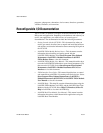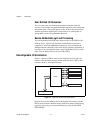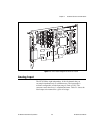
Chapter 1 Introduction
NI 7831R User Manual 1-6 ni.com
You can use Interactive Front Panel Communication to communicate
directly with the VI running on the FPGA. You can use Programmatic
FPGA Interface Communication to programmatically control and
communicate with FPGA VIs from host VIs.
Use the FPGA Interface functions when you target LabVIEW for Windows
or an RT target to create host VIs that wait for interrupts and control the
FPGA by reading and writing the FPGA VI running on the R Series device.
Note If you use the R Series device without the FPGA Module, you can use the Download
VI or Attributes to Flash Memory utility available by selecting Start»Program Files»
National Instruments»NI-RIO to download precomplied FPGA VIs to the flash memory
of the R Series device. This utility is installed by the NI-RIO CD. You also can use the
utility to configure the analog input mode, to synchronize the clock R Series device to the
PXI clock (for NI PXI-7831R only), and to configure when the VI loads from flash
memory.
LabVIEW Real-Time Module
The LabVIEW Real-Time Module extends the LabVIEW development
environment to deliver deterministic, real-time performance.
You can write host VIs that run in Windows or on RT targets to
communicate with FPGA VIs that run on the NI 7831R. You can develop
Real-Time VIs with LabVIEW and the LabVIEW Real-Time Module, and
then download the VIs to run on a hardware target with a real-time
operating system. The LabVIEW Real-Time Module allows you to use the
NI 7831R in RT Series PXI systems being controlled in real time by a VI.
The NI 7831R plug-in device is designed as a single-point AI, AO, and DIO
complement to the LabVIEW Real-Time Module. Refer to the LabVIEW
Real-Time Module User Manual and the LabVIEW Help, available by
selecting Help»VI, Function, & How-To Help, for more information
about the LabVIEW Real-Time Module.


















